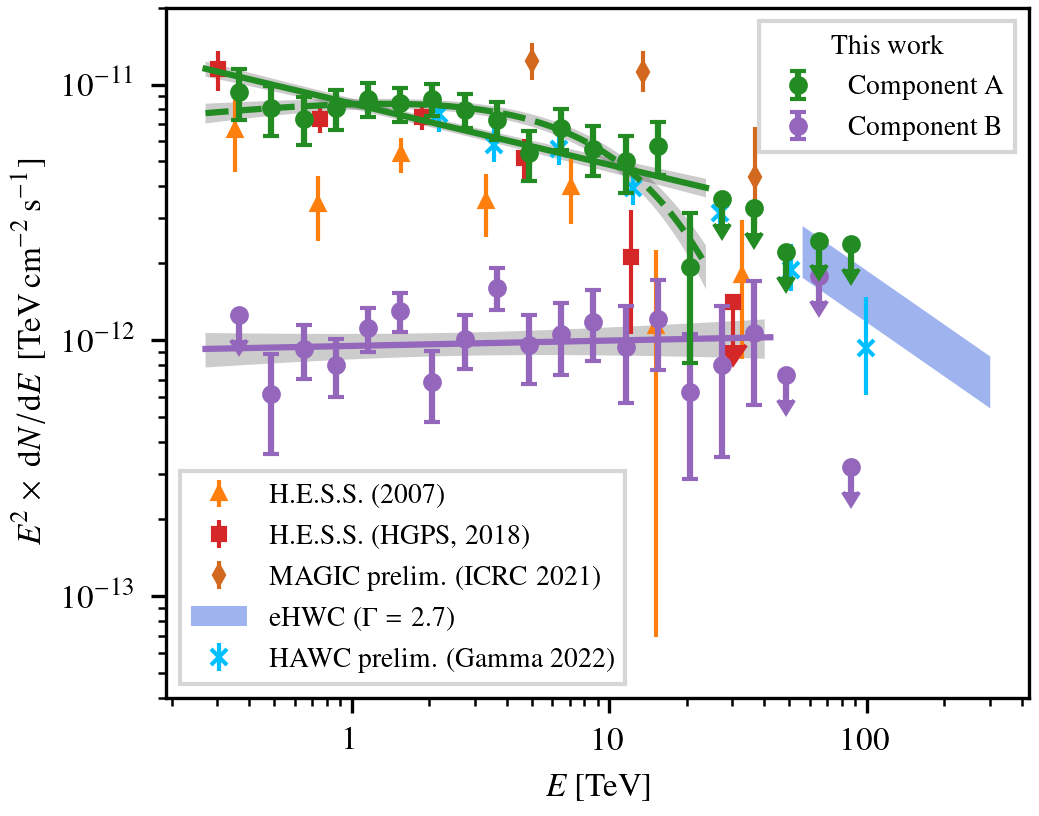Investigating the origin of the very-high-energy gamma-ray source HESS J1809–193
Added: March 9, 2023.
HESS J1809–193 is a very-high-energy gamma-ray source discovered with H.E.S.S. during its survey of the Galactic plane. Its position is coincident with that of the energetic pulsar PSR J1809–1917, which powers a pulsar wind nebula (PWN) that has been detected in X-ray measurements. The gamma-ray emission has therefore originally been associated with the PWN, that is, interpreted as being produced by high-energy electrons and positrons provided by the pulsar in a process called inverse-Compton emission.
Several supernova remnants (SNRs) and molecular gas clouds are also present in the region of HESS J1809–193, however, which has led some authors to suggest that the gamma-ray emission could also be due to cosmic-ray nuclei, accelerated in the SNRs and interacting in the gas clouds. Recently, the HAWC gamma-ray observatory has detected gamma rays with energies of up to ~100 TeV from HESS J1809–193, making this object ever more interesting. However, the limited angular resolution of HAWC prevents a detailed study of the morphology of HESS J1809–193 (i.e. its spatial structure).
Recently, the H.E.S.S. Collaboration has published in Astronomy & Astrophysics a new study about HESS J1809–193. The analysis of the H.E.S.S. data has been performed by me, and uses improved analysis methods compared to earlier studies. In addition, I have been involved in the modelling presented in the paper, and have prepared the figures and written the text.

The figure above shows flux maps (above an energy of 0.27 TeV) of HESS J1809–193, for the full region (left) and for the bright peak of the emission (right). As a new feature of the analysis, we have been able for the first time to resolve the emission into two components, whose spatial morphology and energy spectra we model simultaneously. The spatial models of the two components are illustrated in the flux maps in green and purple (where the dots denote the best-fit position and the dashed lines the 1-σ Gaussian extent). Component A, shown in green, appears elongated and describes the large-scale emission. Component B, shown in purple, is more compact and describes the bright peak of the emission near the pulsar, which is marked with the black triangle. An interesting observation is that component B is slightly shifted from the location of the pulsar, but is coincident with the shell of an SNR (cyan circle) and molecular gas clouds (red, blue).

The plot on the right shows the energy spectra we have measured for the two components (again shown in green and purple for component A and B, respectively), together with measurements from the literature. While component A appears to exhibit a drop in flux above ~10 TeV, the spectrum of component B seems to extend to higher energies.
To investigate the origin of the two components of HESS J1809–193, we have performed a detailed modelling of the gamma-ray emission, considering both the possibility that the emission is due to electrons and positrons or due to cosmic-ray nuclei. We have found that the extended component (A) can best be modelled as a halo of old electrons that have escaped the PWN at some time in the past. The origin of the compact component (B), on the other hand, is more unclear, as we found both scenarios (electrons/positrons or cosmic-ray nuclei) to be viable explanations. Nevertheless, our study represents a big step towards understanding the origin of HESS J1809–193.
HESS J1809–193 has been selected as the March 2023 H.E.S.S. Source of the Month.
Paper reference: A&A 672, A103 (2023).
DOI: 10.1051/0004-6361/202245459
Pre-print: arXiv:2302.13663
